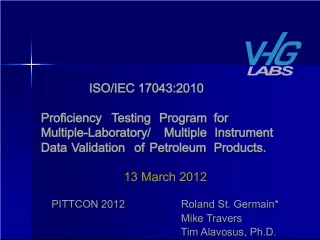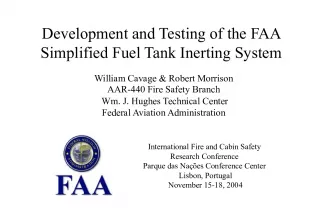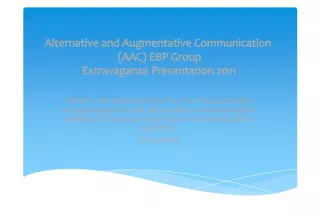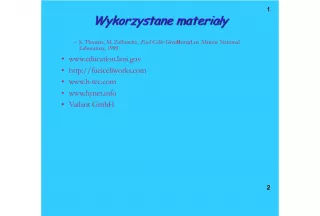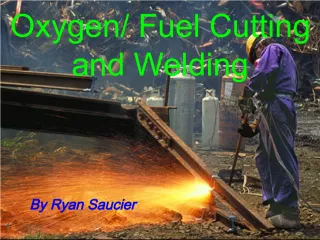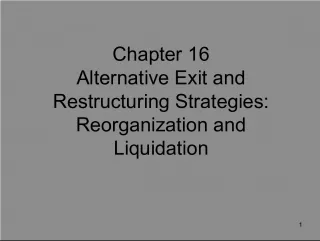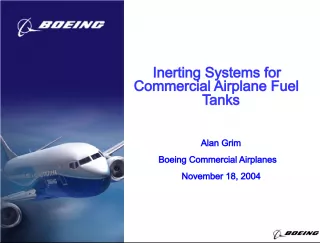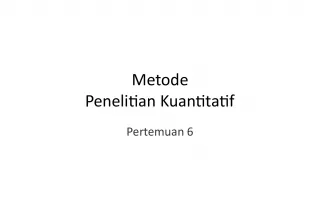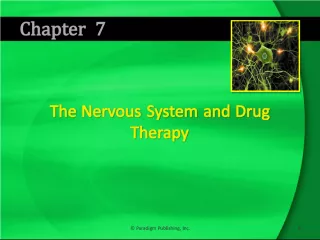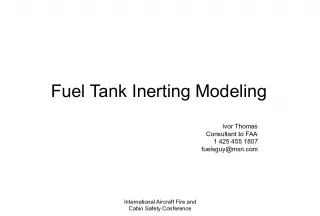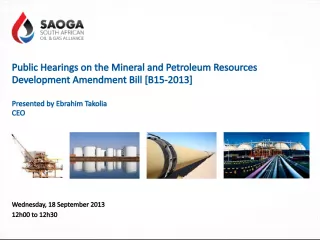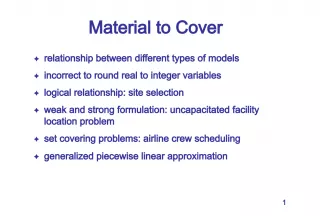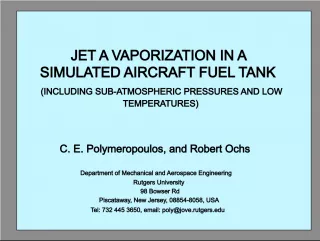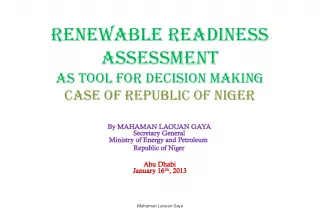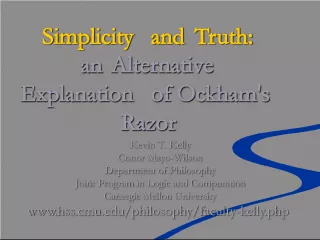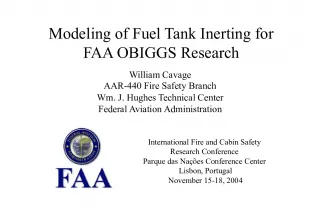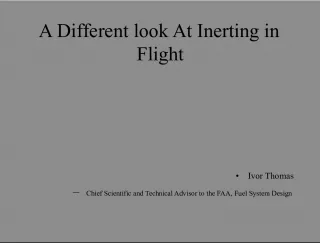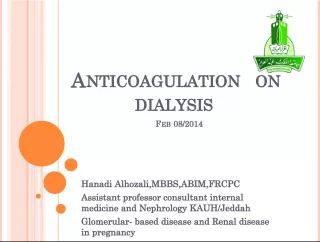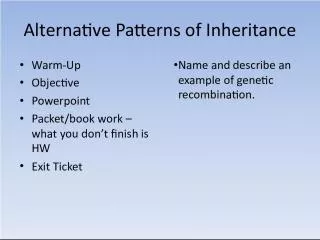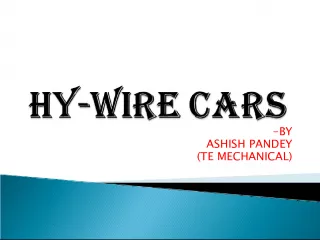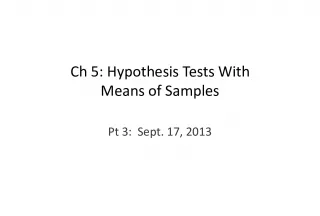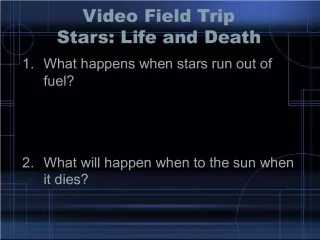Formulation of Petroleum and Alternative Jet Fuel Surrogates


This presentation will cover the formulation of petroleum and alternative jet fuel surrogates. Peter S. Veloo from Exponent Failure Analysis Associates in Los Angeles, CA, Sang
- Uploaded on | 2 Views
-
 ishaan
ishaan
About Formulation of Petroleum and Alternative Jet Fuel Surrogates
PowerPoint presentation about 'Formulation of Petroleum and Alternative Jet Fuel Surrogates'. This presentation describes the topic on This presentation will cover the formulation of petroleum and alternative jet fuel surrogates. Peter S. Veloo from Exponent Failure Analysis Associates in Los Angeles, CA, Sang. The key topics included in this slideshow are . Download this presentation absolutely free.
Presentation Transcript
Slide1Formulation of Petroleum andAlternative – Jet Fuel Surrogates Peter S. Veloo Exponent, Failure Analysis Associates, Los Angeles, CA Sang Hee Won & Frederik L. Dryer Department of Mechanical and Aerospace Engineering, Princeton University, NJ Stephen Dooley Department of Chemical and Environmental Sciences, University of Limerick, Ireland The 7th International Aircraft Fire and Cabin Safety Research Conference Philadelphia, PA 5 th December 2013
Slide22Gas Turbines and Chemical Kinetics Coupling chemical kinetics and computational fluid mechanics for engine design Kinetically limited processes Nitrogen oxide production Soot formation Flame stability Blow out J Campbell, J. Chambers, Patterns in the sky: natural visualization of aircraft flow fields. NASA SP-514,1994
Slide33Aviation Fuels – Composition Distillation Temperature Carbon Number Distributions Hydrocarbon Class Distribution T. Edwards, L.Q. Maurice, J. Propulsion Power 17 (2001) JP-4 JP-8 JP-7 Cycloparafins n -Parafins Naphthalenes i -Parafins Alkylbenzenes
Slide44Aviation Fuels – Fuel Variability Aromatics Content Cetane Index Significant variability in physical and chemical properties Current certification not highly constraining Petroleum Quality Information System Annual Report (2009) Fraction of delivered JP-8 fuels with specified properties
Slide55Surrogate Fuel Concept Computational fluid dynamics coupled with detailed chemical kinetics requires a simplified fuel model Real Fuel Surrogate Fuel Abundance Distillation Temperature Ideal surrogate fuel must emulate combustion behavior and physical properties of a target real fuel
Slide66Surrogate Fuels – Previous Work Numerous jet fuel surrogate postulations present in literature (e.g.): Sarofim et al. ─ Surrogate fuel to model jet fuel pool fires Bruno et al. ─ Surrogate fuel to model thermo-physical properties of jet fuel Require detailed characterizations of target fuel (GC, NMR, …) Significant uncertainty in chemical kinetics of selected surrogate compounds Sarofim et al., Combust. Sci. Tech, 177 (2005) 715–739 T.J. Bruno et al., Ind. Eng. Chem. Res 45 (2006) 4371–4380
Slide77Surrogate Fuels – Present Approach GOAL: Emulate gas phase combustion behavior of a target jet fuel
Slide8C4 C 3 C 2 C 1 CH 3 O C 2 H 5 C 2 H 3 CH 3 O 2 CH 3 HCO HO 2 H O OH Real fuels – Many generic initial chemical functionalities Fewer distinct chemical functionalities after initial oxidation Distinct functionalities govern radical and small species concentrations Surrogate fuel need only reproduce: distinct chemical functionalities
Slide99Surrogate Fuels – Present Approach GOAL: Emulate gas phase combustion behavior of a target jet fuel Identified critical combustion property targets : Adiabatic flame temperature Enthalpy of combustion Flame speed / burning rate Fuel diffusive properties Sooting propensity Auto-ignition • Manifest in important practical combustion behavior • Surrogate fuel must emulate critical fuel properties of target real fuel
Slide1010Surrogate Fuels – Present Approach Quantify critical fuel property targets : Adiabatic flame temperature Enthalpy of combustion Flame speed / burning rate Fuel diffusive properties Sooting propensity Auto-ignition The ratio of hydrogen to carbon (H/C) -CHN analysis (ASTM D5291) Smoke point measurement (ASTM D1322) Average molecular weight (MW avg ) Derived cetane number (ASTM D6890)
Slide1111Case Study 1 – Fuel Surrogate for Jet A n -Alkanes 28% cyclo -Alkanes 20% iso -Alkanes 29% Alkylbenzenes 18% Naphthlenes 2% Selected Surrogate Fuel Components n -Dodecane iso -Octane n -Propylbenzene 1,3,5-Trimethylbenzene Dooley et al., Combust Flame (2010) 157:2333-2339 Dooley et al., Combust Flame (2012) 159: 1444-4466
Slide1212Surrogate Fuel Formulation Algorithm Characterize target Jet A Characterize surrogate components and their mixtures Emulate H/C, DCN, TSI, MWavg Compare gas phase combustion characteristics between surrogate and target Experimental observations • Intermediate species profiles • Flame speeds / extinction limits • Soot volume fraction • Ignition delay times Regression analysis to determine surrogate composition Characterize target Jet A • H/C • Cetane number • Smoke point • Average molecular weight Develop library of target measurements for individual and mixtures of surrogate components
Slide1313Surrogate Fuel Compared with Real Jet-A Fuel Equivalence Ratio, - Jet A - Surrogate Laminar Flame Speed, cm/s p = 1 atm, T u =400 K Laminar Flame Speeds Dooley et al., Combust Flame (2010) 157:2333-2339 Dooley et al., Combust Flame (2012) 159: 1444-4466
Slide1414Surrogate Fuel Compared with Real Jet-A Fuel Extinction Strain Rate, s -1 Fuel Mass Fraction, X Y - Jet A - Surrogate Extinction Limits Dooley et al., Combust Flame (2010) 157:2333-2339 Dooley et al., Combust Flame (2012) 159: 1444-4466
Slide1515Surrogate Fuel Compared with Real Jet-A Fuel Soot Volume Fraction - Jet A - Surrogate Radial Location (mm) Soot Volume Fraction (ppm) Dooley et al., Combust Flame (2010) 157:2333-2339 Dooley et al., Combust Flame (2012) 159: 1444-4466
Slide1616Case Study 2 – Fuel Surrogate for S-8 Mono-methylated Alkanes 61% Di-methylated Alkanes 25% Normal-Alkanes 12% Selected Surrogate Fuel Components n -Dodecane iso -Octane Dooley et al., Combust Flame (2012) 159: 3014-3020
Slide1717Surrogate Fuel Compared with Real S-8 1000K/T Ignition Delay Time Shock tube ignition delay times Dooley et al., Combust Flame (2012) 159: 3014-3020
Slide1818Chemical Kinetic Modeling Large spread in predictions using latest chemical kinetic reaction models for surrogate components Lack of consensus within kinetic modeling community
Slide1919Uncertainties in Numerical Calculations Propagation of uncertainties from rate parameters to numerical simulations Numerical Uncertainty
Slide2020Concluding Remarks Demonstrated surrogate fuel methodology to capture gas phase combustion behavior of aviation fuels Reaction model rate parameter uncertainties require further reduction Application of surrogate concept to polymer combustion Determine surrogates that represent functionalities present in gas phase pyrolysis products
